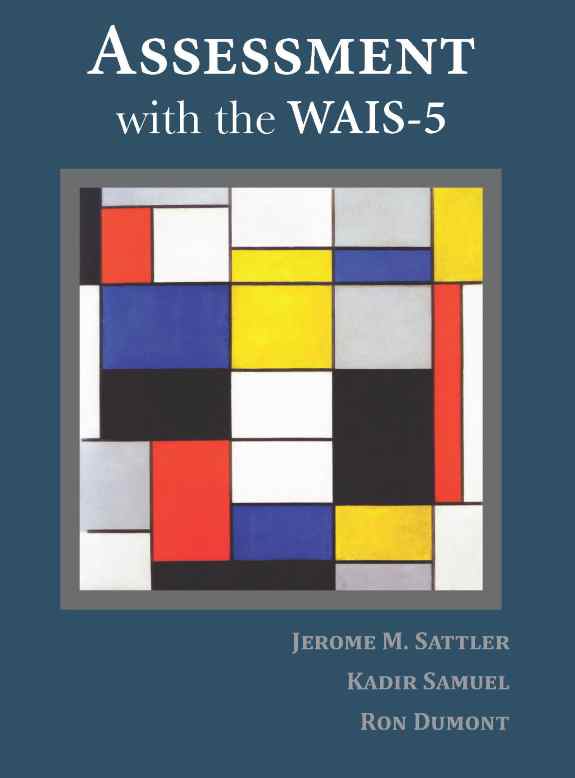|
COMPLETE TABLE OF
CONTENTS
ASSESSMENT with the WAIS5
Jerome M. Sattler, Kadir Samuel, and
Ron
Dumont
Copyright 2025, 468 pages
Hardbound, 8.5 x 11
ISBN 979-8-9928867-0-2
- |
|
Chapter 1. Conducting the Assessment
Evaluator Characteristics
Preparing for the First Meeting
Establishing Rapport
Observing Individuals
Administering Tests to Culturally and Linguistically Diverse Individuals
Administering Tests to Older Adults
Administering Tests to Individuals with Special Needs
Strategies of Becoming an Effective Evaluator
Computer-Based Assessment
Comments on Challenges in Assessing Individuals
Thinking Through the Issues
Summary
Key Terms
Study Questions
Chapter 2.
Wechsler Adult Intelligence Scale, Fifth Edition
(WAIS-5): Description
A Note About Terminology
Standardization
Standard Scores and Scaled Scores
Reliability
Validity
Intercorrelations for Subtests and Scales
Factor Analysis
Tables Needed to Obtain Various WAIS-5 Scores
Range of Subtest and Process Score Scaled Scores
Range of Primary and Ancillary Index Scores
Range of Full Scale IQs
Guidelines for Computing FSIQs, Primary Index
Scores, and Ancillary Index
Scores
Comparison of the WAIS-5 and the WAIS–IV
Administering the WAIS-5
Choosing Between the WAIS-5 and the WISC–V
Administering the WAIS-5 to Individuals with Disabilities
Strengths of the WAIS-5
Limitations of the WAIS-5
Concluding Comment
Thinking Through the Issues
Summary
Key Terms
Study Questions
Chapter 3.
WAIS-IV Subtests
1.
Similarities
2. Block Design
3.
Matrix Reasoning
4.
Digits Forward
5. Digit Sequencing
6. Coding
7.
Vocabulary
8.
Figure Weights
9.
Visual Puzzles
10. Running Digits
11.
Symbol Search
12.
Information
13.
Arithmetic
14. Digits Backward
15. Symbol Span
16. Naming Speed Quantity
17.
Comprehension
18. Set Relations
19. Spatial Addition
20.
Letter-Number Sequencing
Thinking Through the Issues
Summary
Key Terms
Study Questions
Chapter 4.
Interpreting the WAIS–IV
FSIQ
Primary Index Scales
Ancillary Index Scales
Profile Analysis
A Successive‑Level Approach to Test Interpretation
Steps in Analyzing a WAIS-5 Protocol
Estimated Percentile Ranks
Age and WAIS-5 Performance
Comment on Interpreting the WAIS-5
Test Your Skill
Thinking Through the Issues
Summary
Key Terms
Study Questions
Chapter 5. Report Writing
Guidelines
Sections of a
Psychological Report
Principles of Report Writing
Questions
to Assess the Quality of a Psychological Report
Illustration of a Portion of a Psychological Report
Comment on Report Writing
Thinking Through the Issues
Summary
Key Terms
Study Questions
Chapter 6. Introduction to Neuropsychological Assessment, Including
the WAIS-5
Aspects of the Human Brain
Lateralization
Attention
Memory
Language and Symbolic Disorders
Traumatic Brain Injury
Aging and Brain Functioning
Neurological Examination
Neuropsychological Examination
WAIS-5 as Part of a Neuropsychological Examination
Comment on the WAIS-5
Rehabilitation Programs
Recommendations for Further Reading
Thinking Through the Issues
Summary
Key Terms
Study Questions
Chapter
7. Aging and Cognitive Ability
Profile of the Aging American Population
Aging and Fne and Gross Motor Functions
Aging and Sensory Systems
Aging and Cognitive Functions
Thinking Through the Issues
Summary
Key Terms
Study Questions
Chapter
8. Dementia
Disorders Associated with Dementia
Factors that Placed Individuals at Risk for Dementia
Symptoms of
Dementia
Cognitive Impairment
Assessment of Dementia
Functional Ability and Dementia
Psychological Needs of People with Dementia
Commercial Cognitive
Training Programs
Law Enforcement and Dementia
Death Rates and
Dementia
Concluding Comment on Dementia
Recommendations for Further Reading
Thinking Through the Issues
Summary
Key Terms
Study Questions
Appendixes
A. Quantitative Tables for the WAIS-5
B. Miscellaneous Tables for the WAIS-5
References
Name Index
Subject Index
Back to top
|

